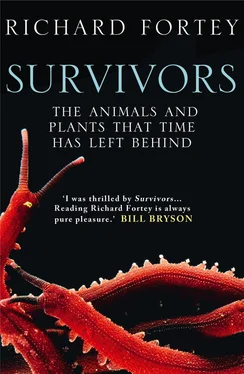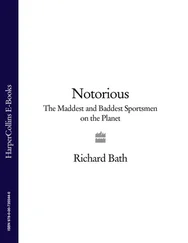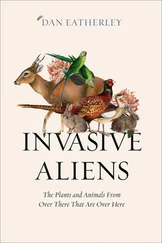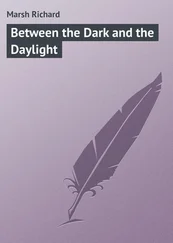1 ...8 9 10 12 13 14 ...21 The head of Peripatus is most obviously identified by its pair of antennae. But close to the front on the underside is the mouth, which is provided with sickle-like jaws to either side, each equipped with a pair of blades at the tip that are produced by a local thickening of the skin, or cuticle. They are simple but efficient shredders. The ducts for the slime glands open at the side of the head. There are no eyes. As for the legs, they are little more than stumpy projections off the body equipped with muscles internally to swing them backwards and forwards. Their feet carry two sickle-shaped claws at their tips, which are much like the jaws in structure; this may indeed provide a clue to the evolutionary origins of the more specialised jaw. Males and females are similar, except that the former are usually a little smaller and are less common.
Inside they are pretty simple, too. The major part of the body is taken up with the stomach, which runs along the length of the animal to the anus at the end. Between the gut and the mouth there is a short oesophagus and a muscular pharynx, which is used for initial food processing. Oxygen absorption is achieved through tiny tubes inside the body called tracheae that have their apertures located in depressions between the papillae. There are no special gills or lungs because animals of this size can get all the oxygen they need through thinned parts of the cuticle. The heart is another simple tube, positioned at the top of the body above the stomach. The rest of the vascular system is much as in the horseshoe crab Limulus, distributed rather diffusely through the internal cavity. Peripatus gets rid of its waste products by means of nephridia, kidney-like organs, located in the legs along with small excretory openings. The nerve cord is a double structure running along most of the length of the animal, with cross connections that make it look somewhat like a ladder: nerves extend from this into the segments and limbs. A larger ganglion in the head is all that this basic creature can display as a brain.
Simple though it may be, the velvet worm functions perfectly well. For a moving animal, there is quite a short list of vital functions: sensory equipment to find a source of food and tools to help eat it; a method of locomotion; a way to breathe and distribute oxygen to internal organs; a system of waste disposal; a reliable way to propagate the species. Peripatus would be the kind of creature one might put together from a ‘how to make an animal’ kit, except that like almost everything else in nature it has some tricks all its own – its gluey trap, its ability to produce little peripati by live birth. It is a simple creature in many features, specialised in other subtle ways; but it is also another old timer, a messenger from the distant past.
Its more recent history is not very different from that of the podocarp trees. Peripatus and its relatives number about two hundred living species (placed together in Phylum Onychophora, informally known as ‘onychophorans’). *They also have a distribution over the areas that once formed Gondwana: Australia, New Zealand, South Africa, South America and Assam (India). There are also velvet worms in Irian Jaya and New Guinea, where it is very likely that further species still remain to be discovered in mountainous and inaccessible areas. All of them carry the long memory of the vanished supercontinent as they tramp their unadventurous way on their stubby legs. Velvet worms had once wandered over Gondwana but, like the podocarps and southern beeches, new species arose on the separate pieces of the progressively fragmented continent; for evolution does not stand still. I could have gone in search of the velvet worm in any one of these other regions. The New Zealand species I happened to pursue is particularly interesting because it has developed a relationship with a special kind of termite that is regarded as the most primitive of its kind (of the Family Kalotermitidae), among which most individuals finish up as flying insects. The other termites are noted for their extraordinary caste system, with specialist workers and soldiers that never change their roles. It seems possible that a whole primitive ecology was transferred to New Zealand when Gondwana broke up, and there it endured, virtually unchanged, encased in logs. But something did change. I found Peripatus inside a pine log belonging to a species that was not native to New Zealand, so at some recent date the velvet worm must have followed its termite prey into a new habitat. You can teach old worms new tricks.
Since the velvet worm has a body as soft as dough it is most unlikely to be preserved as a fossil. Shells and bones leave behind their hard evidence, but can we expect a shy, soft package of flesh to do the same? Even the Solnhofen Limestone fails to preserve a single fossil of a Peripatus. Fortunately, there is one example preserved in Cretaceous amber from Burma (Myanmar), perhaps 100 million years old, a contemporary of the dinosaurs. Amber preserves the most evanescent of creatures: flies, beetles, even mushrooms. This fossil species is very like the living Peripatus and there is no question that it lived in a similar fashion. It provides the proof that velvet worms of modern type were alive at the break-up of the Gondwana supercontinent – which is good to know although we might infer it anyway from their distribution today. But we want to go back much further than this, 200 million years earlier. A remarkably preserved impression from the Carboniferous called Helenodora tells us that in the swamps of the coal measures, distant relatives of the velvet worm – but still eminently recognisable – were wandering their deliberate way through the damp undergrowth. Their contemporaries at this stage in the evolution of life were inelegant amphibians and very early reptiles, accompanied by the first flying insects. The velvet worm was terrestrial then, just as it is now. It may even have developed its special slimy-gluey glands, although at this early date it must have fed on something other than termites: for these insects were not even a twinkle in the eye of evolution in the Carboniferous. The velvet worm is beginning to look at least as ancient as the horseshoe crab. The velvet worm likewise survived the great extinction at the end of the Permian, and then it slid through the major event that secured the removal of the dinosaurs from our planet; like Limulus’ ancestors, Peripatus is made of sterner stuff, not to be seen off by mere global catastrophes. But now there comes a surprise. When we go back yet another 200 million years all the way to the Cambrian Period, to the time of ‘explosive’ evolution at the beginning of complex animal life, there, too, were relatives of velvet worms – they prove to be more common as fossils in Cambrian rocks than they are in rocks laid down in later geological periods. They began their history under the sea, in the cradle of life, like everything else. And they proved to be survivors. They shared their early world with trilobites, and the first relatives of horseshoe crabs, and the distant ancestors of scorpions. So much in biology seems to converge back more than 500 million years ago to the Cambrian ancient sea floor. The ancestors of the velvet worms were yet another kind of animal that later moved onto land – and this happened at least 300 million years ago. Because of their rarity as fossils it is not possible to say whether velvet worms got onto land before or after scorpions; we shall probably never know. Unlike scorpions, they needed to stay in wet, or at least humid environments, but just like those venomous arachnids none of their close relatives managed to survive to the present day beneath the sea. For Peripatus and its relatives going on land was arriving at some sort of haven.
Probably the best-known onychophoran from the Cambrian is called Aysheaia pedunculata. It was named a century ago by the renowned palaeontologist Charles Dolittle Walcott of the Smithsonian Institution, Washington. It occurs in what is probably also the most famous rock formation of that age, the Burgess Shale of British Columbia, Canada. A locality near Mount Field in the Rocky Mountains discovered by Walcott yielded the first known, diverse fossil fauna of ‘soft bodied’ organisms, that is, those lacking hard mineralised shells, which are the kinds that give us ‘regular’ fossils. The Burgess Shale allows us to see something of the whole panoply of marine life at a seminal time – although admittedly it only samples the larger organisms. The fossils are preserved as silvery films on the surface of the black shale, so that they are subtle casts made by fine minerals before the animals could be scavenged or they fell apart. The exact circumstances of their preservation are still being debated, but it is certain that quick burial and protection from normal decay played an important part. Whatever the cause, Aysheaia is preserved in extraordinary detail.
Читать дальше












